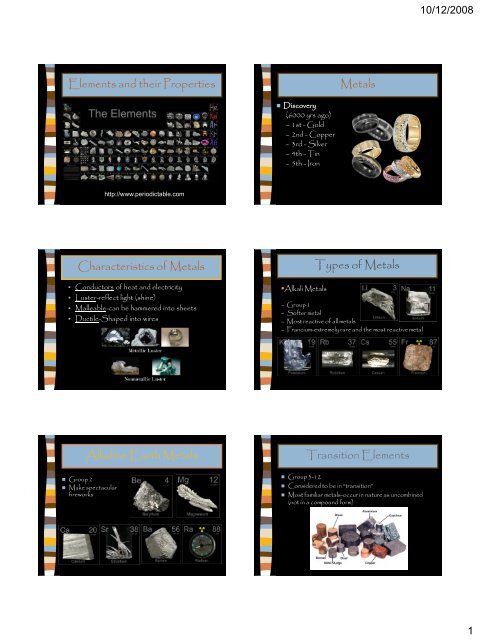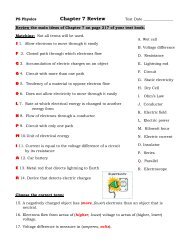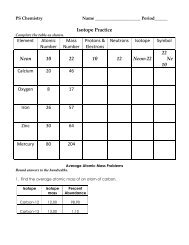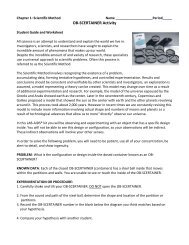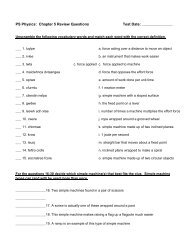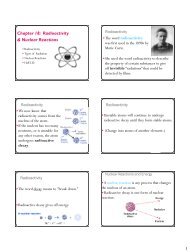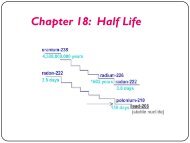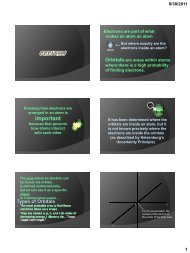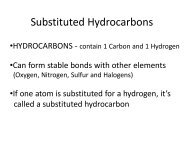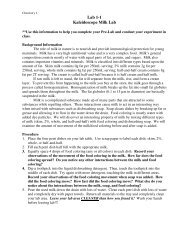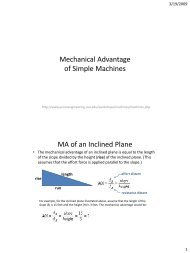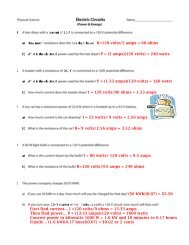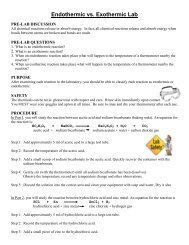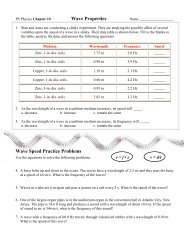Elements and their Properties
Elements and their Properties
Elements and their Properties
Create successful ePaper yourself
Turn your PDF publications into a flip-book with our unique Google optimized e-Paper software.
10/12/2008<br />
<strong>Elements</strong> <strong>and</strong> <strong>their</strong> <strong>Properties</strong><br />
Metals<br />
• Discovery<br />
(6000 yrs ago)<br />
– 1st - Gold<br />
– 2nd - Copper<br />
– 3rd - Silver<br />
– 4th - Tin<br />
– 5th - Iron<br />
http://www.periodictable.com<br />
Characteristics of Metals<br />
Types of Metals<br />
• Conductors of heat <strong>and</strong> electricity<br />
• Luster-reflect light (shine)<br />
• Malleable-can be hammered into sheets<br />
• Ductile-Shaped into wires<br />
•Alkali Metals<br />
– Group 1<br />
– Softer metal<br />
– Most reactive of all metals<br />
– Francium-extremely rare <strong>and</strong> the most reactive metal<br />
Alkaline Earth Metals<br />
Transition <strong>Elements</strong><br />
• Group 2<br />
• Make spectacular<br />
fireworks<br />
• Group 3-12<br />
• Considered to be in “transition”<br />
• Most familiar metals-occur in nature as uncombined<br />
(not in a compound form)<br />
1
10/12/2008<br />
Inner Transition Metals<br />
Non-Metals<br />
• Lanthanides<br />
– 58-71<br />
– Follow Lanthanum<br />
• Actinides<br />
– 90-103<br />
– Follow Actinium<br />
– Radioactive <strong>and</strong> unstable<br />
• Found to the right of the “stair-step” line except for<br />
Hydrogen<br />
• Unusually gases or brittle solids<br />
• Not malleable or ductile<br />
• Don’t conduct heat or electricity<br />
Hydrogen<br />
Halogens<br />
• Diatomic molecule- 2 atom of the same element bonded<br />
together<br />
• Most hydrogen on earth is found in water.<br />
• Hydrogen as an atom is very reactive.<br />
• Group 17<br />
• 7 valence electrons<br />
• Fluorine-most<br />
chemically active of al<br />
elements<br />
Noble Gases<br />
Mixed Groups<br />
• Very Stable<br />
• Energy levels are “full”<br />
• 8 valence electrons<br />
• Groups 13-17<br />
• Contain metals,<br />
nonmetals, <strong>and</strong><br />
metalloids<br />
2
10/12/2008<br />
Metalloids<br />
Boron Family<br />
• Stair-step line (except Aluminum)<br />
• Share unusual characteristics<br />
• Can have both metallic <strong>and</strong> nonmetallic properties<br />
• Group 13<br />
• Aluminum is the most<br />
abundant metal is<br />
Earth’ crust<br />
• 3 Valence electrons<br />
Carbon Family<br />
Nitrogen Family<br />
• Group 14<br />
• Carbon is essential to life<br />
• Silicon is second in<br />
abundance in Earth’s crust.<br />
• Semiconductor-conducts<br />
electric current under certain<br />
conditions.<br />
• Allotropesthe<br />
same element<br />
has different<br />
molecular structures<br />
• Group 15<br />
• 5 Valence electrons<br />
• Nitrogen is the 4th most<br />
abundant element in your<br />
body<br />
Oxygen Family<br />
Synthetic <strong>Elements</strong><br />
• Group 16<br />
• 6 Valence electrons<br />
• Oxygen is found<br />
diatomic (O 2 )<br />
• <strong>Elements</strong> having more<br />
than 92 protons<br />
• Created in labs<br />
• Unstable atoms<br />
• Mixed groups<br />
• 2006 - Element 118 was<br />
discovered (it’s life is<br />
0.66 milliseconds)<br />
3


